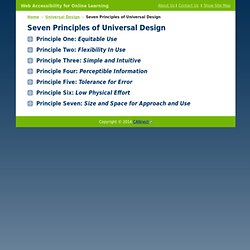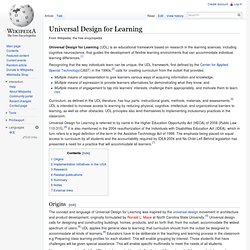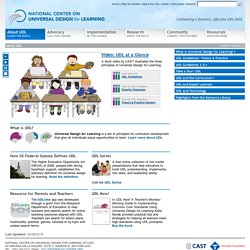

Seven Principles - Universal Design - Web Accessibility for Online Learning. Principle One: Equitable Use "The design is useful and marketable to people with diverse abilities.

" This principle recommends that the same intuitive and attractive interface be used by all students to access web content. In relation to people with disabilities, this means that students with motor disabilities that limits use of the mouse are able to access the web content solely via the keyboard; that students who are blind can effectively navigate and understand web content utilizing a screen reader; that students with low-vision can use screen magnification software and customize the styling of web content to suit their needs; and that deaf students have synchronized captions for video content and transcripts for audio.
Principle Two: Flexibility In Use. Universal Design for Learning. Universal Design for Learning (UDL) is an educational framework based on research in the learning sciences, including cognitive neuroscience, that guides the development of flexible learning environments that can accommodate individual learning differences.[1] Recognizing that the way individuals learn can be unique, the UDL framework, first defined by the Center for Applied Special Technology(CAST) in the 1990s,[2] calls for creating curriculum from the outset that provides: Multiple means of representation to give learners various ways of acquiring information and knowledge,Multiple means of expression to provide learners alternatives for demonstrating what they know, andMultiple means of engagement to tap into learners' interests, challenge them appropriately, and motivate them to learn.[3][4]

About UDL. A short video by CAST illustrates the three principles of Universal Design for Learning.

How US Federal Statute Defines UDL The Higher Education Opportunity Act (HEOA) of 2008, passed with strong bipartisan support, established the statutory definition for universal design for learning. Read the definition UDL Series. About UDL. Georgia. Universal Design for Learning Guides, Part 1: Principles of Universal Design.